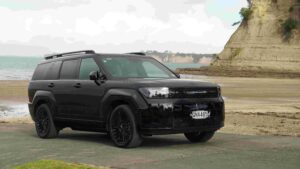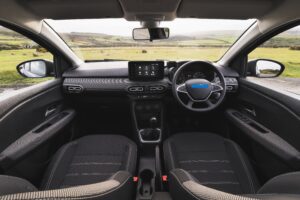The Ford Ranger is designed to explore the road less travelled and get filthy dirty in the process. But leaving your Ranger covered in mud, salty sand or drenched in sea water after a weekend away off-roading isn’t a great idea. From pre-soaking the underside of your Ranger to rinsing off salt water, cleaning the engine bay and everything in between, here’s what you need to know about cleaning your Ranger after a dirty weekend.
Pre-soak to shift mud – If you’ve been off-roading anywhere muddy then there’s a good chance your Ranger will have mud caked up inside the wheel arches, the chassis and other parts of the body. Rather
than getting underneath your rig with a garden hose and washing off the mud onto your driveway, you could visit a DIY hand car wash and use a high-pressure hose. Or, if you’ve got a front or back lawn you can park on, why not park your Ranger on that and then sit a sprinkler underneath to loosen the mud.
Whether you soak with a pressure washer or place a sprinkler under your rig, you’re still going to need to get underneath your vehicle with a hose and wash out the loosened mud and grit. Be nice and thorough with this process as mud has a way of finding its way into all sorts of nooks and crannies, but don’t get too close if you’re using a high-pressure hose or you could end up stripping parts that have been stone chipped. This is why spraying carefully and thoroughly is the way to go.
If you’re washing your Ranger at home, then get your garden hose and use it to flush out the chassis rails until the water runs clear. You should be able to feed the hose through one of the holes in the rails and then just move it backwards and forwards to help flush out any muck. Make sure you give the leaf springs a good wash too; they can get squeaky if grit is allowed to accumulate. Similarly, make sure body and door drainage holes aren’t caked with mud.
Wash off saltwater straight away – Rather than a bog hole out the back of beyond, what if your weekend away was to the beach but you stayed on the sand and didn’t go anywhere near the water? It doesn’t matter whether you only drove on the sand or got your Ranger splashed with sea water, or you had to cross a river mouth on the beach that had salt water in it, you need to thoroughly clean your Ranger’s undercarriage. This generally involves getting a garden hose and flushing out the chassis rails until the water is running clear and your confident all the saltwater residue and sand has been cleaned out.
Once you’ve flushed the chassis rails with fresh water, you’ll need to follow the same advice as when cleaning mud out from the undercarriage and give the underneath of your Ranger a good clean with a hose or pressure washer.
Cleaning the body – Whether you’ve been playing in muddy puddles or spent time at the beach if you’re reading this then you should have a good idea on how to keep the underneath of your Ranger nice and clean. Now it’s time to start on your truck’s body and while you could complete this step at a DIY car wash, there’s nothing like going old school and using your garden hose and a couple of buckets; we’ll focus on this method. Although, if you are using a pressure washer, remember not to get too close to the body or you could end up blowing water past seals and damaging your vehicle.
Washing your car by hand is the preferred way to go because you can take your time and inspect your truck while you’re cleaning it. This way, you’ll spot anything that isn’t right, like chips in the paint, broken plastic or chunks out of the tyres. Just remember that using dishwashing liquid is a big no-no, only use approved car shampoo.
If you’re using two or three buckets, then you’ll be using one bucket for the body, one bucket for the tyres and wheels and one for rinsing. Add your preferred car shampoo solution to manufacturer’s guidance to two of the buckets of water and leave the other one filled with clean water only. Give the body a good rinse down to help loosen any muck and then get into it with the soapy sponge working your way from the top down. Make sure to rinse your sponge or mitt regularly in the clean water bucket so that you’re not putting grit and muck back into your cleaning bucket and rinse off your vehicle with your hose as you go.
If your Ranger has stripes or graphics on it, then you’ll need to be particularly careful when using a pressure washer; hand washing is the preferred way to clean them. But, if you are going to use a pressure washer, then make sure you use a wide spray pattern, don’t get closer than 300mm to the surface, and only angle the spray at 90-degrees to the body. Angling the spray could damage the graphics and cause the edges to peel.
Cleaning wheels and tyres – Grab your non-car-body sponge or mitt, or even a specialized wheel brush and using your second bucket of soapy (car shampoo) water get stuck into the wheels and tyres. An accumulation of caked on mud inside the rim can throw your vehicle’s wheel alignment out, so it pays to pay as much attention when cleaning the wheels as it does to any other part of your vehicle.
Washing the engine bay – Most of us never ever look in the engine bay, or think about cleaning it when washing our trucks, but we should. In the same way mud and salt spray can get into the nooks and crannies under our vehicle, it can also splash up into the engine bay; so, we need to keep it clean. And if we combine it with a fluid check (windscreen washer, brake, engine oil, coolant) then we’re doing two jobs at once.
Never, ever, try and clean your engine bay with a pressure washer because while Ranger is Built Ford Tough a pressure washer can cause damage to wiring and even bend the fins on the radiator. And make sure your engine is cool to the touch before poking around under the bonnet; never try and clean the engine bay when the engine is running.
Preparation is key when cleaning the engine bay. For instance, you’ll want to do things like covering the battery, power distribution box and air filter assembly with plastic to prevent damage. And never wash or rinse any ignition coil, spark plug wire or sparkplug well. Make sure you familiarize yourself with the components in the engine bay. Take a vacuum and use it to remove any debris that might have accumulated at the base of the windscreen. Remove the engine cover if your Ranger has one before spraying cleaner into the engine bay. Grab a can of approved engine degreaser or shampoo and give the engine bay a good spray following the manufacturer’s instructions. Working from the front to the back rinse the engine bay. Remove plastic coverings from the battery and other sensitive electronics.
Cleaning the interior – This is a relatively simple step and requires a vacuum, a cleaning cloth, some window cleaner and some elbow grease. Remove your vehicle’s mats and seat covers (if fitted) and
clean them separately with a vacuum or, if you’ve got rubber floor mats, clean them with some soapy water and a sponge, rinse them and then lay them out in the sun to dry. Take a damp cloth and wipe down all the interior surfaces. Once you’ve given the interior a dust then grab your vacuum and give the carpets and seats a clean. Last thing are the windows. The outside should be nice and clean already so take some window cleaner (without ammonia is better) and give the inside of the windows a spray and wipe.
With the last window cleaned you can now take a step back and admire your sparkling clean Ranger, at least until the next time you take it off-road.










